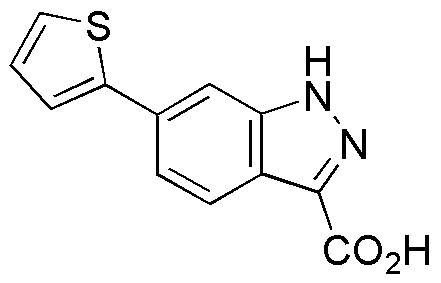6-Thiophen-2-yl-1H-indazole-3-carboxylic acid is widely utilized in research focused on:
- Pharmaceutical Development: This compound plays a crucial role in the synthesis of new drugs, particularly in the development of anti-inflammatory and analgesic agents, offering potential alternatives to existing medications.
- Biochemical Research: It is used as a tool in studying various biochemical pathways, helping researchers understand disease mechanisms and identify new therapeutic targets.
- Material Science: The compound is explored for its properties in creating advanced materials, such as organic semiconductors, which are essential for developing efficient electronic devices.
- Agricultural Chemistry: It shows promise in the formulation of agrochemicals, contributing to the development of safer and more effective pesticides and herbicides.
- Analytical Chemistry: This chemical is utilized in analytical methods for detecting and quantifying other compounds, enhancing the accuracy of chemical analysis in various industries.
General Information
Properties
Safety and Regulations
Applications
6-Thiophen-2-yl-1H-indazole-3-carboxylic acid is widely utilized in research focused on:
- Pharmaceutical Development: This compound plays a crucial role in the synthesis of new drugs, particularly in the development of anti-inflammatory and analgesic agents, offering potential alternatives to existing medications.
- Biochemical Research: It is used as a tool in studying various biochemical pathways, helping researchers understand disease mechanisms and identify new therapeutic targets.
- Material Science: The compound is explored for its properties in creating advanced materials, such as organic semiconductors, which are essential for developing efficient electronic devices.
- Agricultural Chemistry: It shows promise in the formulation of agrochemicals, contributing to the development of safer and more effective pesticides and herbicides.
- Analytical Chemistry: This chemical is utilized in analytical methods for detecting and quantifying other compounds, enhancing the accuracy of chemical analysis in various industries.
Documents
Safety Data Sheets (SDS)
The SDS provides comprehensive safety information on handling, storage, and disposal of the product.
Product Specification (PS)
The PS provides a comprehensive breakdown of the product’s properties, including chemical composition, physical state, purity, and storage requirements. It also details acceptable quality ranges and the product's intended applications.
Certificates of Analysis (COA)
Search for Certificates of Analysis (COA) by entering the products Lot Number. Lot and Batch Numbers can be found on a product’s label following the words ‘Lot’ or ‘Batch’.
*Catalog Number
*Lot Number
Certificates Of Origin (COO)
This COO confirms the country where the product was manufactured, and also details the materials and components used in it and whether it is derived from natural, synthetic, or other specific sources. This certificate may be required for customs, trade, and regulatory compliance.
*Catalog Number
*Lot Number
Safety Data Sheets (SDS)
The SDS provides comprehensive safety information on handling, storage, and disposal of the product.
DownloadProduct Specification (PS)
The PS provides a comprehensive breakdown of the product’s properties, including chemical composition, physical state, purity, and storage requirements. It also details acceptable quality ranges and the product's intended applications.
DownloadCertificates of Analysis (COA)
Search for Certificates of Analysis (COA) by entering the products Lot Number. Lot and Batch Numbers can be found on a product’s label following the words ‘Lot’ or ‘Batch’.
*Catalog Number
*Lot Number
Certificates Of Origin (COO)
This COO confirms the country where the product was manufactured, and also details the materials and components used in it and whether it is derived from natural, synthetic, or other specific sources. This certificate may be required for customs, trade, and regulatory compliance.


